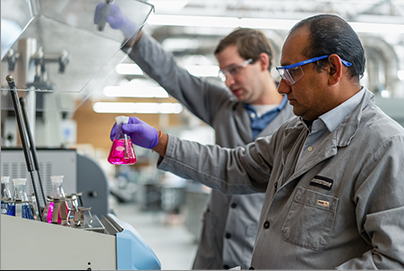
Bridgestone Americas (Bridgestone) today announced it received a grant from the U.S. Department of Energy (DOE) Industrial Efficiency and Decarbonization Office. Bridgestone will design, build and operate a pilot plant that will advance an innovative, potentially more sustainable and cost-effective approach to obtaining butadiene from ethanol. The project will evaluate the economic and commercial viability, as well as the carbon footprint, of converting ethanol to butadiene.
The company plans to utilize the butadiene produced to further study and confirm the potential use as a feedstock for raw materials in Bridgestone tires.
“Projects like this will help advance the science and technologies necessary to make the industry more sustainable, placing our engineers and scientists at the forefront of potentially revolutionizing how tire makers obtain butadiene in a more nature-positive way,” said Dr. Mark Smale, Bridgestone Executive Director of Core Polymer Science. “We are very excited about this project and the innovative new process, and very appreciative of the DOE’s support.”
The DOE grant was awarded due to the project’s aim of reducing greenhouse gas emissions and moving the nation closer to a net-zero economy.
Bridgestone has partnered with Pacific Northwest National Laboratory, or PNNL, for this project. The process will utilize and scale an innovative and proprietary catalyst system originally developed by PNNL and further co-developed through research activities with Bridgestone. It is this unique catalyst combined with Bridgestone’s innovative process engineering that holds the promise of establishing a commercially viable new way of thermochemically converting ethanol to butadiene.
Butadiene is a key ingredient in tires today and typically represents the No. 1 ingredient (by volume) in synthetic rubber that is derived from fossil fuels. The goal of this project is to assess, and hopefully prove, the economic viability of deriving butadiene from ethanol conversion versus fossil fuel conversion. If the economics prove viable, then low carbon intensity ethanol (or ethanol derived from bio-based or recycled materials) could replace the use of fossil fuels in the process to obtain butadiene.
The project officially starts this month and will span at least three years:
- Year 1 – Design of the pilot plant
- Year 2 – Build the pilot plant (Akron, Ohio)
- Year 3 – Staff and operate the pilot plant
This project is the latest example and tangible proof of Bridgestone efforts to pioneer sustainable solutions and live out its E8 Commitment in the areas of “Ecology,” “Energy” and “Efficiency.”
This innovative new process could represent a major step forward for Bridgestone as it progresses along its sustainability journey, advancing toward Bridgestone’s goal of using 100% sustainable raw materials in its tires globally by 2050.
“Projects like this will help advance the science and technologies necessary to make the industry more sustainable, placing our engineers and scientists at the forefront of potentially revolutionizing how tire makers obtain butadiene in a more nature-positive way. We are very excited about this project and the innovative new process, and very appreciative of the DOE’s support.” – Dr. Mark Smale, Bridgestone Executive Director of Core Polymer Science.
About Bridgestone Americas
Bridgestone Americas, Inc. is the U.S.-based subsidiary of Bridgestone Corporation, a global leader in tires and rubber, building on its expertise to provide solutions for safe and sustainable mobility. Headquartered in Nashville, Tenn., Bridgestone Americas employs more than 45,000 people across its worldwide operations. Bridgestone offers a diverse product portfolio of premium tires and advanced solutions backed by innovative technologies, improving the way people around the world move, live, work and play.
Source
Bridgestone Americas, press release, 2024-10-22.
Supplier
Share
Renewable Carbon News – Daily Newsletter
Subscribe to our daily email newsletter – the world's leading newsletter on renewable materials and chemicals













